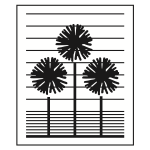Design Strategy: Resiliency
 In the wake of Hurricane Irma, resiliency became a bit of a buzz word here in Southwest Florida. As we drove throughout our community checking on clients’ homes and helping neighbors wherever we could, we thought about the word quite a bit ourselves. Are our designs as resilient as they can be? What can we do differently to better prepare for the next hurricane season?
In the wake of Hurricane Irma, resiliency became a bit of a buzz word here in Southwest Florida. As we drove throughout our community checking on clients’ homes and helping neighbors wherever we could, we thought about the word quite a bit ourselves. Are our designs as resilient as they can be? What can we do differently to better prepare for the next hurricane season?
Across the board, our clients suffered minimal damage in their gardens. This was good news. Even newly established landscapes held their own. We noticed that one of our favorite trees, the Gold Tree, was among the most commonly felled from the storm. We’ll be taking that into account when we incorporate those specimens into future designs.
The fallen branches that carpeted our yards after Irma were actually a blessing in disguise. Michael is quoted in a Herald Tribune article following the storm:
“Every hour, the tree lost more leaves, more small branches, and it kind of cleaned and thinned itself so that when the big winds got here, there was less mass for that wind to pull against. That is not an accident. That is how nature thins itself out so it did not have a catastrophic fail.”
In the same Herald Tribune article, Michael also emphasized the importance of caring for larger canopy trees.
“Have a certified arborist come out every two years or so and make sure your trees are healthy, and that they are not a hazard to come over (in wind events). That can be exacerbated by poor drainage or building a structure nearby that impacts the roots…The tree might look completely healthy to the naked eye, but you get an arborist come out and he discovers cavity rot, or this tree has too much weight on one side. They can start a management plan to mitigate for that, by reducing the weight of the tree, or removing hazardous branches that have a poor connection, so that when you do have a wind event like this, the trees don’t fail.”
The majority of our preventative work was done after the storm passed. We offered this advice to our clients as soon as our power was restored:
“In addition to the immediate wind damage to our landscapes, such as broken branches and debris, we will see farther reaching effects of Hurricane Irma in the weeks and months to come. You will notice the effects of wind damage becoming apparent through browning foliage from wind burn. We expect to see fungal issues throughout the landscape. Many tropical palms had their buds damaged or exposed to the winds. Many trees and shrubs that blew over, even partially, have sustained root damage. This kind of damage, along with excessive water and heat, is a recipe for fungal activity. We are making the following recommendations and moving forward with a regimen for preventative damage control.
- Preventative fungus control on all palms, trees and shrubs that suffered wind damage.
- Minor nutrient application to promote and stimulate root growth on all palms, trees and shrubs that blew over.
- Trimming of all damaged fronds and foliage (typically we would not perform a hard prune this late in the season, but it is necessary to remove damaged foliage and reduce weight from material that has fallen over).
- In some cases, power is still out which means that wells and/or irrigation timers are not working. We recommend hand-watering newly planted landscapes if possible until power is restored. An established landscape should be able to sustain a week or two without water.
- Please remember to reset irrigation timers when your power is back on; our maintenance account managers will help our current clients with this.”
It was deeply rewarding to realize, house by house, that our clients’ landscapes would survive and thrive following this epic hurricane. Resiliency is something we have considered, and will continue to consider, in every design that leaves our office.
